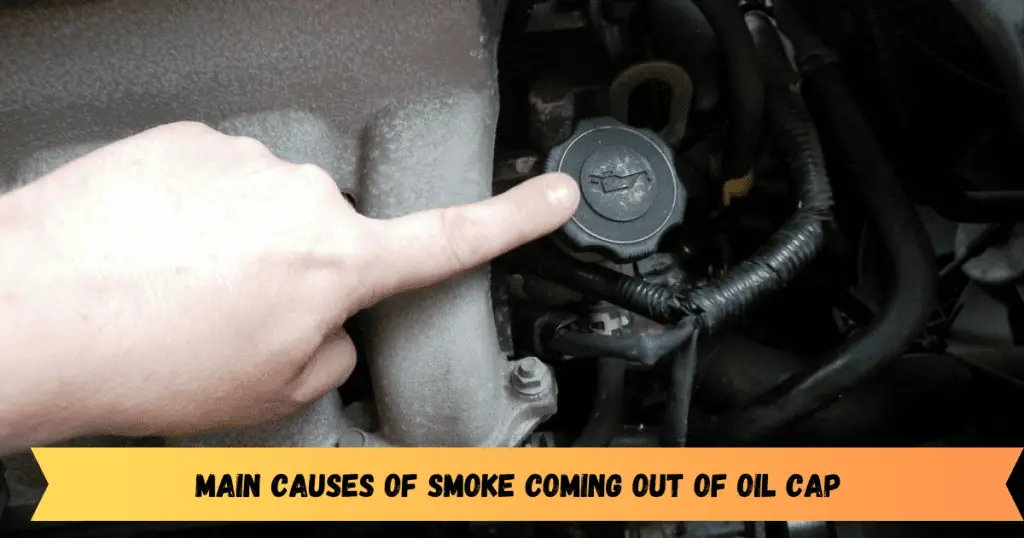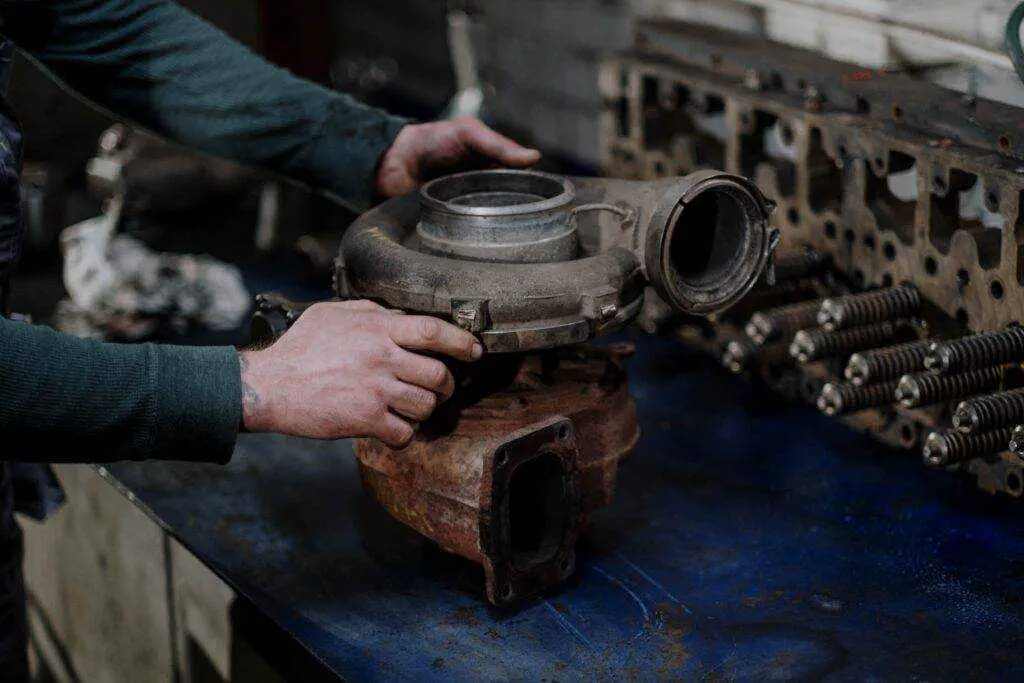Smoke coming out of oil cap from your engine can be alarming. Smoke signals potential internal issues like worn piston rings, valve guide seals, and clogged PCV systems.
In this article, we’ll examine:
- Causes of oil cap smoke
- Colored smoke meanings
- Effects of leaked oil
- Engine testing diagnostics
- Estimating repair costs
- DIY fixes to try
- When to call a mechanic
- FAQs on oil cap smoking
Identifying why your engine leaks oil into the crankcase and generates Smoke Coming Out Of Oil Cap is crucial to selecting the right fix. Let’s explore the possible reasons and solutions for this issue.
Main Causes of Smoke Coming Out Of Oil Cap
Several key problems can lead to smoke from the oil fill cap:

Worn Piston Rings – Damaged rings allow oil and combustion gases to leak past into the crankcase. This pressurizes the lower end and forces smoke out the cap.
Failed Valve Seals/Guides – Hardened seals and worn guides let oil drip into the cylinders. This gets burned in combustion and exits as smoke.
Clogged PCV System – Blocked valves and hoses don’t return vapors to the intake to be burned off. Pressure builds and forces smoke through the cap.
Excessive Blow-by Gases – Worn cylinders, pistons, and rings allow excessive exhaust gases to blow by into the crankcase rather than exiting the tailpipe.
Damaged Breather Gasket – A torn or hardened breather gasket allows pressure leaks and lets oil escape.
Overfilled Oil – Too much oil overflows the crankcase and gets churned into foam. This can force oil and smoke through the cap.
Pinpointing which of these internal issues is the root cause determines the necessary repairs.
What Does the Color of Smoke From Oil Cap Mean?
The color and density of the smoke provide clues about its source:
White Smoke – Thick white smoke signals coolant leaks being burned in the cylinders. This requires cooling system repairs.
Blue/Gray Smoke – Blue-tinted smoke points to oil consumption from worn rings, valves, cylinders, and other internal parts allowing oil into the chambers.
Black Smoke – Sooty, fouled oil being burned creates black smoke. This indicates excess blow-by gases straining the crankcase ventilation.
Thin Smoke – Very thin white/blue smoke is often just water vapor from condensation collecting in the crankcase and then exiting the cap normally. Less concerning.
Monitor the color and density closely. White or black smoke alongside oil loss necessitates engine repairs.
What Effects Does an Oil Leak Have?
An engine oil leak leading to Smoke Coming Out Of Oil Cap produces several negative effects:
Reduced Oil Level – Oil makes its way past rings and valves rather than lubricating properly, consuming the supply faster.
Power Loss – Oil fouling spark plugs and combustion chambers reduce firing efficiency and engine output.
Blow-by Gases – Combustion gases leaking into the crankcase contaminate the oil, reducing its lubrication ability and service life.
Emissions Rise – Unburned fuel and gases escape into the crankcase rather than exiting the tailpipe normally, raising exhaust emissions.
Oil Odor – The smell of fouled burning oil enters the cabin through the ventilation system.
So while a minor leak may not immediately catastrophic, the cumulative effects on engine performance are very detrimental if left unaddressed.
How to Diagnose Cause of Smoke Coming Out Of Oil Cap
Use these tips to narrow down why your engine is generating Smoke Coming Out Of Oil Cap:
Check Oil Level and Color
Inspect the level and change intervals to ensure the oil isn’t severely overfilled. Check the color and consistency – a milky contaminant present points to coolant mixing in from a head gasket or other failure. Thick, black oil indicates heavy blow-by contamination.
Perform a Leak-down Test
A leak-down test pressurizes each cylinder and then measures how much and how quickly the pressure drops. High leakage points to worn rings or valves allowing combustion gases to escape past into the crankcase.
Monitor Blue Smoke at Startup
Notice if smoke appears only on initial startup after sitting. This often points to oil leaking past worn valve guide seals and filling the cylinders overnight. Starting and warming up burns it off as blue smoke initially.
Check for PCV Faults
Inspect PCV components like the valve, hoses, and grommets for cracks and obstructions. Make sure the system isn’t clogged, causing excessive pressure in the crankcase.
Do an Oil Consumption Test
Check oil levels frequently to calculate the consumption rate. 1 quart burned every 1,000 – 1,500 miles point to internal oil leaks past rings or valves.
Perform a Compression Test
This can identify compression loss from worn pistons, rings, cylinders, valves, and heads allowing gases to escape into the crankcase instead of properly combusting.
Proper diagnostics pinpoint whether upper engine repairs or short block work is needed to address root causes.
Average Repair Costs for an Oil-Leaking Engine
Typical repair costs to address internal leaks causing oil cap smoke include:
Valve seals – $400-$800
Seal replacement: $250-$500 in labor
Piston rings – $1500-$4000
Ring replacement along with cylinder honing: $1000-$3500 in parts and labor
Blown head gasket – $1200-$2000
Gasket replacement: $800-$1500 in labor
Engine rebuild – $4000-$8000
Full rebuild with cylinders, rings, bearings, etc.: $3000-$7000 in parts and labor
PCV system – $150-$300
Hoses, valves, and grommets: $100-$250 in parts and labor
Prices vary based on engine size, location, and chosen shop rates. Diagnostics adds about $100-$200 to pinpoint issues.
Can I Fix Oil Cap Smoking Myself?
Some DIY repairs you can attempt before resorting to a full rebuild:
Change oil – Flush old contaminated oil and replace the filter. Fill to the proper level.
Clean PCV components – Remove and soak valves, hoses, and grommets in solvents to clear clogs.
Replace breather gasket – A torn gasket lets oil leak and smoke at high pressures. Install a fresh OEM replacement.
Use thicker oil – Step up viscosity to 20W-50, etc. It can better seal rings and guides temporarily.
Try engine restore additive – Helps swell seals to slow leaks. Results vary based on deterioration extent.
Adjust valve lash – Worn hydraulic lifters can cause excessive guide and seal wear. Shimming can tighten the lash.
These DIY fixes aim to clean and slow leaks buying some time before major engine work is required.
Frequently Asked Questions
What color of smoke signals an oil leak?
Look for blue-gray-hued smoke, as opposed to pure white or black smoke, to indicate oil making its way into the combustion chamber and being burned.
Can bad valve stem seals cause white smoke?
Yes, worn seals allow oil to leak past into the cylinders overnight leading to white/blue smoke at initial startup that burns off as the engine warms up.
Does thick white smoke always mean a head gasket failure?
Not necessarily. A damaged head gasket is one possibility for coolant leaking into cylinders and creating thick white smoke. But other cooling system component failures can also introduce coolant that gets burned.
Can you drive with a bad PCV valve?
It’s possible to drive with PCV system faults but this allows pressure buildup, oil leaks past rings and valves, higher emissions, and oil contamination. PCV issues should be addressed promptly.
What causes blow-by gases in the crankcase?
Worn pistons, rings, cylinders, and other deficiencies allow combustion gases to blow past into the crankcase rather than exiting the tailpipe. This pressurizes the crankcase and forces smoke from the oil cap.
How much does piston ring replacement cost?
You’ll typically pay $1500-$4000 for piston ring replacement in a standard passenger vehicle. Parts run $500-$2000 and labor around 10 hours. Bent valves or cylinders require additional repairs.
Conclusion
Smoke from your engine oil fill cap demands prompt diagnosis and repair to mitigate larger issues down the road. While some vapor release is normal from crankcase ventilation, consistent smoke points to leaks allowing oil into combustion chambers. Repair costs vary dramatically based on whether valve seals, piston rings, head gaskets, or other major engine repairs are required. Look for related symptoms and use engine tests to pinpoint root causes accurately. In general, smoke from the oil cap accompanied by oil loss necessitates professional diagnosis and repair to prevent accelerated engine wear and smoking.





